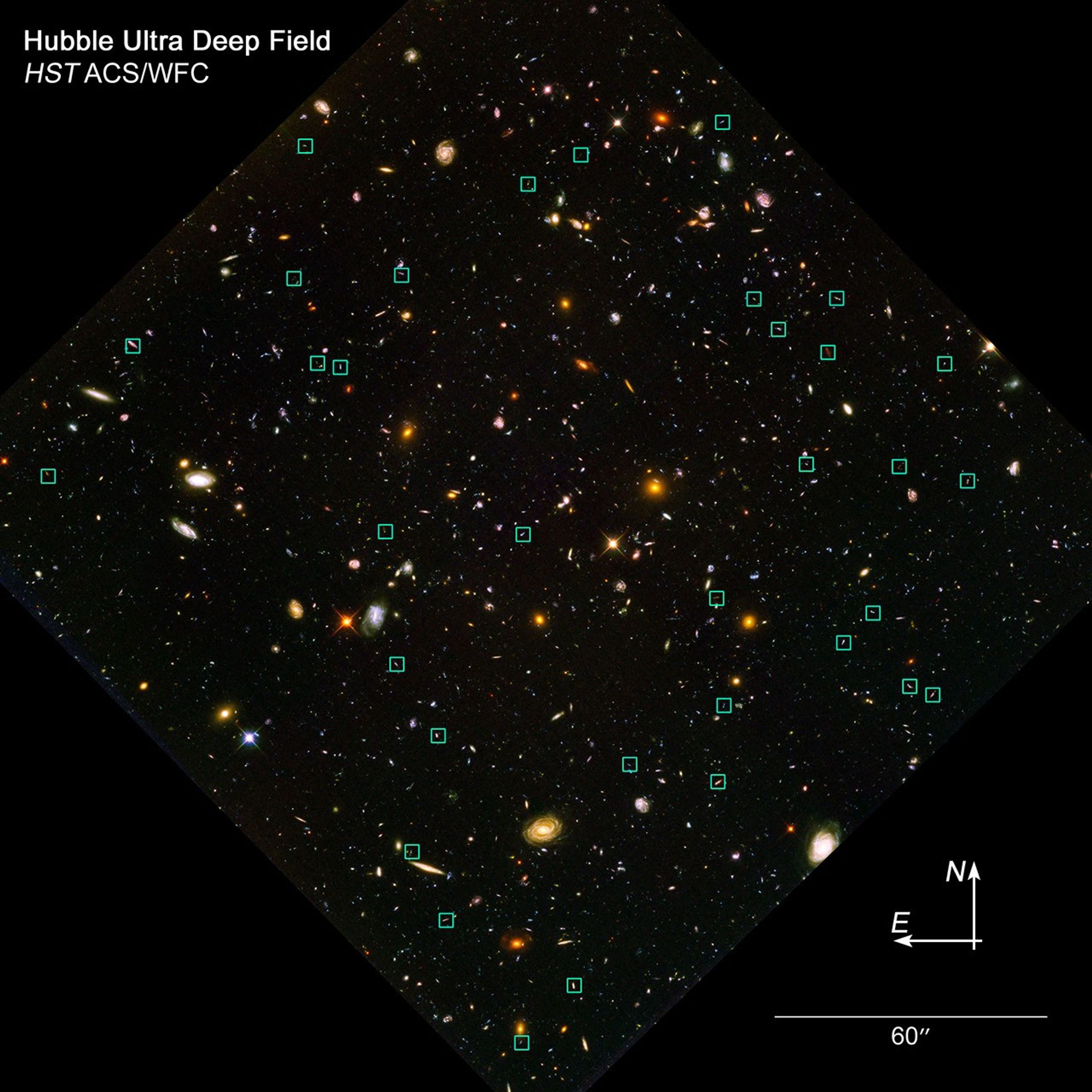1 min read
A Gallery of ‘Tadpole Galaxies’

These postage-stamp-size images reveal 36 young galaxies caught in the act of merging with other galaxies. These galaxies appear as they existed many billions of years ago. Astronomers have dubbed them "tadpole galaxies" because of their distinct knot-and-tail shapes, which suggest that they are engaging in galactic mergers.
The galaxies were captured in 2004 in the Hubble Space Telescope's Ultra Deep Field (HUDF) survey of thousands of distant galaxies. They are part of more than 165 tadpole galaxies in the HUDF studied recently by a team of astronomers. The team was looking for indications of black hole activity in these young galaxies. A characteristic signature of such activity is a fluctuation in brightness over time, an indication that a black hole is feasting on surrounding stars and gas. The flickering light does not come from the black hole itself but from the area immediately surrounding the black hole. Astronomers did not see brightness fluctuations in any of the tadpole galaxies they surveyed. They did, however, observe the fluctuations in 46 different faint galaxies in the HUDF. These galaxies existed millions of years after the tadpole galaxies. This result suggests that black holes did not begin eating when galaxies merged. Rather, it took several hundred million years for the gas and stars from the merger to arrive on the black hole's dinner plate and become visible as flickering light. This finding agrees with recent computer models which predicted that the feeding habits of black holes would become visible after galactic mergers.
Each postage-stamp image is roughly 84,000 light-years on a side, which is about the size of our Milky Way Galaxy today. The tadpole galaxies are shown in the middle of each image and are considerably smaller than today's giant galaxies. The image was taken by Hubble's Advanced Camera for Surveys.
About the Object
- R.A. PositionR.A. PositionRight ascension – analogous to longitude – is one component of an object's position.03h 31m 59.99s
- Dec. PositionDec. PositionDeclination – analogous to latitude – is one component of an object's position.-27° 48' 0.0"
- ConstellationConstellationOne of 88 recognized regions of the celestial sphere in which the object appears.Fornax
About the Data
- Data DescriptionData DescriptionProposal: A description of the observations, their scientific justification, and the links to the data available in the science archive.
Science Team: The astronomers who planned the observations and analyzed the data. "PI" refers to the Principal Investigator.This image of the HUDF was created from HST data from the following proposal: 9978: S. Beckwith, S. Malhotra, M. Giavalisco, N. Panagia, J. Rhoads, M. Stiavelli, R. Somerville, S. Casertano, B. Margon, C. Blades, J. Caldwell, and M. Clampin (STScI), M. Corbin (CSC), M. Dickinson, H. Ferguson, and A. Fruchter (STScI), R. Hook (STScI/ECF), S. Jogee, A. Koekemoer, R. Lucas, M. Sosey, and L. Bergeron (STScI). The science team includes: A.N. Straughn, S.H. Cohen, R.E. Ryan Jr, N.P. Hathi, R.A. Windhorst, & R.A. Jansen (Arizona State University), A.M. Koekemoer, N. Pirzkal, C. Xu, B. Mobasher, S. Malhotra, L.-G.Strolger, and J.E. Rhoads (STScI). - InstrumentInstrumentThe science instrument used to produce the data.HST>ACS/WFC
- Exposure DatesExposure DatesThe date(s) that the telescope made its observations and the total exposure time.September 24, 2003 - January 16, 2004, Exposure Time: 11.3 days
- FiltersFiltersThe camera filters that were used in the science observations.F435W (B), F606W (V), F775W (i), F850LP (z)
- Object NameObject NameA name or catalog number that astronomers use to identify an astronomical object.Tadpole Galaxies in the Hubble Ultra Deep Field (HUDF)
- Object DescriptionObject DescriptionThe type of astronomical object.Young galaxies, Tadpole Galaxies
- Release DateJanuary 10, 2006
- Science ReleaseMonster Black Holes Grow After Galactic Mergers
- CreditNASA, A. Straughn, S. Cohen, and R. Windhorst (Arizona State University), and the HUDF team (Space Telescope Science Institute)

Blue: F435W (B) Green: F606W (V), F775W (i) Red: F850LP (z)
Related Images & Videos

Locate the 'Tadpole' Galaxies
Among the thousands of galaxies in this image of the Hubble Ultra Deep Field are the 36 so-called "tadpole" galaxies identified recently by astronomers. The green squares mark these galaxies, which existed billions of years ago. They are called tadpoles because of their distinct...
Share
Details
Claire Andreoli
NASA’s Goddard Space Flight Center
Greenbelt, Maryland
claire.andreoli@nasa.gov































